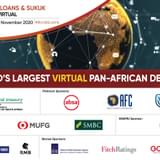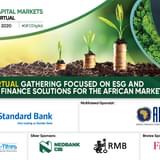Loan markets have traditionally played a vital role in developing Africa’s FI and corporate landscape. And at a time when some international lenders are scaling back their operations in Africa due to increased risk, particularly in economies more exposed to oil and commodities, others – like Commerzbank – are looking to continue supporting their relationships maintain their profile in the region. Bonds & Loans speaks with Andreas Scheer, Head of Loan Capital Markets, Financial Institutions at Commerzbank AG on the outlook for the region’s loan markets, and how changing risk dynamics are influencing pricing and tenor expectations.
Financial institutions were some of the most frequent borrowers in Africa last year, but pricing in some of those markets has changed dramatically over the past 8 months – particularly places like Nigeria or Gabon. How do you see African markets performing in terms of supply and pricing this year? Where do you see bright spots, challenged areas, and what are some of those most influential factors in play?
Traditionally, loan market activity is largely driven by the refinancing of existing loan facilities. With a large volume of maturities coming due this year, South African borrowers – followed closely by African supranational banks – are expected to dominate the African loan market for FI borrowers in 2017 again. Despite various challenges in a number of African economies, especially those currently affected by low oil and commodity prices, interest in the African region generally remains strong due to its enormous economic potential. Many lenders that are active in the region, including ourselves, are hopeful that over time we will see more activity from other territories which used to tap the loan markets in the past again, although that may take some time. The syndicated loan market is expected to play a vital role in this process.
Major factors contributing to the success of transactions continue to be relationship, pricing that works for all involved, availability of ancillary business, and familiarity of international banks with the region and its borrowers. Other important factors are transactions being structured in line with international best practice, mainly based on English Law and in line with documentation standards set by the Loan Market Association (LMA). In terms of pricing for this year’s round of refinancings, we believe that for well-known FI borrowers with a proven track record in the market, it is expected to remain broadly in line with or be slightly more favourable than their most recently concluded transactions – provided market conditions do not degrade materially.
To what extent are we seeing new structures emerge on transactions in Africa? Has increasing risk in some countries on the continent prompted the emergence of new or exotic structures, and have changing risk dynamics influenced pricing and tenor expectations?
Increasing and changing risk dynamics have influenced pricing expectations so far, and will continue to do so, we believe. Still, we are not aware of this having led to the emergence of new structures on a broader scale. There have been a few instances in the past where so called “exotic structures” have been used – for instance, when Skye Bank tapped the market in 2012 with a remittance backed 5-year amortising term loan facility – but it is expected to remain rather uncommon. One reason is certainly that structures that are relatively complex, like these, only appeal to a limited number of investors. Given that they are also likely to carry a premium in pricing over conventional structures, they also tend to be less attractive from the borrowers’ perspective.
Commerzbank led African Export-Import Bank’s US$761mn / EUR105mn dual-tranche loan, easily one of the standout deals in 2016. Can you take us through the syndication strategy? What do you think were some of the major factors leading to the deal’s success? Could the structure be easily replicated for other borrowers?
By tapping the international loan markets over many years, and on a regular basis, Afreximbank has created a sustainable and varied investor base with strong relationships upon which it can continue to build its debt profile. Against this backdrop as well as previous deals, banks supporting the 2016 transaction were primarily attracted from Afreximbank’s core group of relationship banks. The transaction was executed in two stages. The first stage included a club of 12 close relationship banks taking the lead as Initial Mandated Lead Arrangers and Bookrunners, which committed top tickets and provided not only a large portion of the overall facility volume targeted by Afreximbank, but also a balanced mixture in terms of tenors – two years and three years – and currencies – euros and US dollars – to meet the borrower’s and banks’ expectations and requirements.
The second stage featured a more general syndication phase with the amounts raised used to maximize the deal volume. The facility was launched into general syndication at a US$600mn-equivalent, where 14 banks joined the Initial Mandated Lead Arrangers and Bookrunners and took the facility size up to approximately US$872mn.
The general syndication lenders comprised a balanced mixture of institutions from the Middle East, Europe and the Asia-Pacific region. It is also important to note that based on the borrower’s requirements, general syndication lenders were invited to only provide US dollar commitments, which did not deter investors at a time of US dollar strength. Moreover, a significantly greater proportion of funds (73%) raised during the general syndication phase were commitments to the 3-year facility, illustrating the strength of Afreximbank as a credit and investors’ confidence to lend money to the bank for the same time-period generally seen on syndicated loan facilities provided to tier-one South African banks in 2016.
Major factors leading to the deals success were pricing, tenor and structure, which were all in line with market expectations for a borrower of Afrexim’s high standing and the strength of the borrower’s relationships with many banks over the years. With this in mind, and whilst the structure as such can principally be replicated, there is really no one-size-fits-all framework that satisfies the requirements for each and every borrower. There is always a tailor-made solution based on the requirements of the individual case.
Trade finance and development seem inextricably linked in Africa – but many global lenders have been held back from participating in trade finance deals for any number of reasons (compliance, regulations, etc.). How does Commerzbank address some of these challenges so that it can participate with these deals?
Commerzbank has been present in Africa for many years. Our large network of representative offices across the African continent including South Africa, Ethiopia, Egypt, Angola, Libya, Ivory Coast and Nigeria enables a deeper insight and better understanding of the markets locally, which enables us to carefully assess new opportunities on the ground. A large team of professionals with necessary knowledge and expertise covering the African countries is another benefit. And of course, this is supported by longstanding positive business relationships with clients based on mutual trust.
Africa’s capital markets present significant opportunities for global lenders, and in recent years the continent has become much more competitive as a result. How does Commerzbank differentiate from its peers?
Customer satisfaction with the services provided is always the focus of whatever we do. We strongly believe in building mutually beneficial long-term relationships based on trust, openness and high-quality services, thus over time aiming to not only be a liquidity provider but also a trusted advisor and partner.









